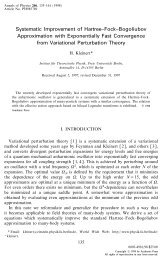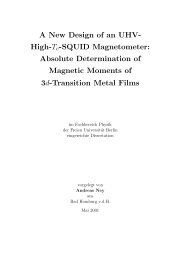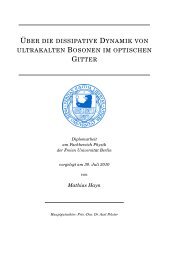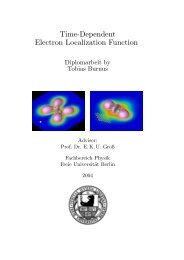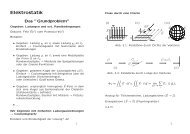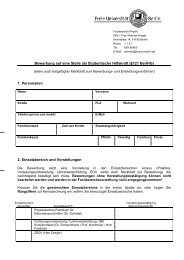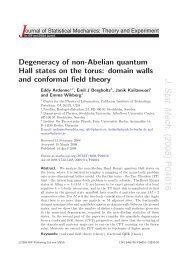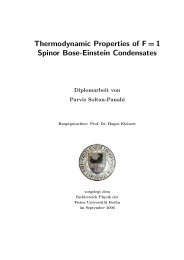Diploma thesis
Diploma thesis
Diploma thesis
You also want an ePaper? Increase the reach of your titles
YUMPU automatically turns print PDFs into web optimized ePapers that Google loves.
4 Complex harmonic potential<br />
oscillator length l = λ −1/2<br />
1 and the energy scale by the ground-state energy 1 Ω of a real harmonic<br />
2<br />
potential to make the calculations and the results more clearly:<br />
ε := E Ω<br />
2<br />
, c := C Ω<br />
, χ := 1 l x, ω := 1 w and κ := l k. (4.19)<br />
l<br />
2<br />
Furthermore we introduce the following abbreviation:<br />
θ = θ(c, ω) =<br />
From this we can directly calculate λ and γ and thus finally obtain<br />
a 1 = 1 4 (1 − ε) and a 2 = 1 4<br />
Using these new variables the general solutions now read<br />
√<br />
1 + i c<br />
ω 2 . (4.20)<br />
(<br />
1 − ε + ic<br />
θ<br />
)<br />
. (4.21)<br />
⎧<br />
⎪⎨<br />
ψ s (χ) =<br />
A s 1e − 1 2 χ2 1F 1<br />
(<br />
a1 ; 1 2 ; χ2) + A a 1χe − 1 2 χ2 1F 1<br />
(<br />
a1 + 1 2 ; 3 2 ; χ2)<br />
A s 2e − 1 2 θχ2 1F 1<br />
(<br />
a2 ; 1 2 ; θχ2)<br />
, χ < −ω<br />
, −ω < χ < ω<br />
, (4.22)<br />
⎪⎩<br />
A s 1e − 1 2 χ2 1F 1<br />
(<br />
a1 ; 1 2 ; χ2) − A a 1χe − 1 2 χ2 1F 1<br />
(<br />
a1 + 1 2 ; 3 2 ; χ2)<br />
, ω < χ<br />
⎧<br />
⎪⎨<br />
ψ a (χ) =<br />
A s 1e − 1 2 χ2 1F 1<br />
(<br />
a1 ; 1 2 ; χ2) + A a 1χe − 1 2 χ2 1F 1<br />
(<br />
a1 + 1 2 ; 3 2 ; χ2)<br />
A a 2θχe − 1 2 θχ2 1F 1<br />
(<br />
a2 + 1 2 ; 3 2 ; θχ2)<br />
, χ < −ω<br />
, −ω < χ < ω<br />
. (4.23)<br />
⎪⎩<br />
−A s 1e − 1 2 χ2 1F 1<br />
(<br />
a1 ; 1 2 ; χ2) + A a 1χe − 1 2 χ2 1F 1<br />
(<br />
a1 + 1 2 ; 3 2 ; χ2)<br />
, ω < χ<br />
Now we demand continuity of the wave function and its first derivative at χ = ±ω. With the<br />
symmetry conditions (4.14) it is sufficient to evaluate this at χ = −ω and to ensure that ψ 1 (χ)<br />
vanishes for χ → −∞, because then the same is automatically fulfilled for ψ 3 at χ = +ω and<br />
χ → ∞. We start with the normalizability:<br />
lim ψ 1(χ) =<br />
χ→−∞<br />
[ (<br />
lim<br />
1<br />
χ→−∞ e− 2 χ2 A s 1 1F 1 a 1 ; 1 )<br />
(<br />
2 ; χ2 + A a 1χ 1 F 1 a 1 + 1 2 ; 3 )]<br />
2 ; χ2<br />
!<br />
= 0. (4.24)<br />
If the confluent hypergeometric functions (4.10) reduce to polynomials, this would be automatically<br />
fulfilled because of the exponential function. In the real case this allows us immediately<br />
to formulate the quantization condition a 1 = −n for some n ∈ N. Unfortunately this does not<br />
work here since a is, in general, a complex number so that the Pochammer symbol (a 1 ) ν does not<br />
vanish even for any n ∈ R and 1 F 1<br />
(<br />
a1 ; 1 2 ; χ2) does not become a polynomial. Therefore we have<br />
to demand that the sum of two confluent hypergeometric functions vanishes for χ → −∞:<br />
lim<br />
[A s<br />
χ→−∞<br />
1 1F 1<br />
(a 1 ; 1 )<br />
2 ; χ2 + A a 1χ 1 F 1<br />
(a 1 + 1 2 ; 3 )]<br />
2 ; χ2 !<br />
= 0. (4.25)<br />
38




